Latest recommendations

| Id | Title * | Authors * | Abstract * | Picture * | Thematic fields * | Recommender | Reviewers | Submission date | |
|---|---|---|---|---|---|---|---|---|---|
07 Oct 2024
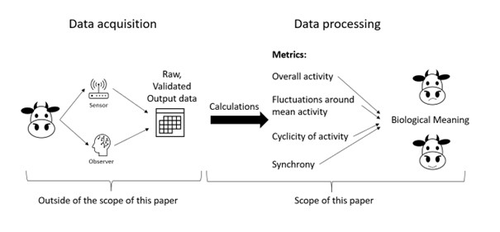
From data on gross activity to the characterization of animal behaviour: which metrics for which purposes?Ingrid D.E. van Dixhoorn, Lydiane Aubé, Coenraad van Zyl ,Rudi de Mol, Joop van der Werf, Romain Lardy, Marie Madeleine Mialon, Kees C.G. van Reenen, and Isabelle Veissier https://doi.org/10.5281/zenodo.10420600A guide to improving the use of activity data in animal researchRecommended by Matteo Chincarini based on reviews by Birte L Nielsen and Anna Olsson based on reviews by Birte L Nielsen and Anna Olsson
In production animals, behavioural activity plays a crucial role across a wide range of scientific disciplines and is often measured for various purposes depending on the field: ethology, animal welfare, reproduction, animal production, and so on. Historically, direct observation was the primary method of collecting such data, a process that was time-consuming and prone to possible observer bias. With the advent of automated systems and sensors, behavioural activity can now be recorded continuously and non-invasively, leading to a growing body of more reliable data (1). However, the lack of standardisation in how these data are calculated and interpreted has created challenges for cross-study comparisons. To fully harness the potential of studying behavioural activity, scientific studies must harmonise the methods used to calculate this measure. Standardising these methods would make it easier to compare results and identify possible gaps in knowledge. In the work by van Dixhoorn et al.(2), the authors examine the various metrics most commonly used to study behavioural activity. Through a series of examples, they address the definitions, calculation methods, and biological significance of metrics such as overall activity, fluctuations around mean activity, cyclicity of activity, and synchrony between animals. The authors suggest how these different metrics can be applied in specific contexts and guide readers in using appropriate terminology to ensure future studies are more easily comparable. In addition, by clarifying these concepts, the authors provide researchers with the tools to make informed decisions about which metric best suits their study's objectives. A key contribution of this work is its emphasis on standardising the metrics and terminology used in behavioural activity studies. Studies using different metrics may arrive at conclusions that appear contradictory, not because of actual differences in animal behaviour, but due to inconsistencies in how behaviour is quantified. By advocating for a common framework, the authors aim to improve the replicability of studies, facilitate meta-analyses, and allow for a more cohesive understanding of animal behaviour across different research groups. This, in turn, could accelerate the identification of key behavioural indicators, ultimately leading to better animal management practices and welfare assessments. This article provides a timely and valuable contribution to the field of animal science. As technology continues to evolve, so too must our methods for interpreting the vast amounts of data it generates (3). By ensuring that studies are comparable and data is interpreted consistently, the research community can work towards more meaningful discoveries in animal behaviour. I highly recommend this paper to researchers looking to deepen their understanding of activity metrics in animal behaviour studies. References 1. Rushen J, Chapinal N, de Passilé AM (2012). Automated monitoring of behavioural-based animal welfare indicators. Animal Welfare 21(3):339-50. https://doi.org/10.7120/09627286.21.3.339 2. van Dixhoorn IDE, Aubé L, van Zyl C, de Mol R, van der Werf J, Lardy R, Mialon MM, van Reenen CG, and Veissier I (2024). From data on gross activity to the characterization of animal behaviour: which metrics for which purposes?. Zenodo, 10420600, ver.5 peer-reviewed and recommended by PCI Animal Science. https://doi.org/10.5281/zenodo.10420600 3. Riaboff L, Shalloo L, Smeaton AF, Couvreur S, Madouasse A, Keane MT (2022). Predicting livestock behaviour using accelerometers: A systematic review of processing techniques for ruminant behaviour prediction from raw accelerometer data. Computers and Electronics in Agriculture 192:106610. https://doi.org/10.1016/j.compag.2021.106610 | From data on gross activity to the characterization of animal behaviour: which metrics for which purposes? | Ingrid D.E. van Dixhoorn, Lydiane Aubé, Coenraad van Zyl ,Rudi de Mol, Joop van der Werf, Romain Lardy, Marie Madeleine Mialon, Kees C.G. van Reenen, and Isabelle Veissier | <p>The behaviour of an animal is closely linked to its internal state. Various metrics can be calculated from activity data. Complex patterns of activity within or between individuals, such as cyclic patterns and synchrony, can inform on the biolo... |  | Animal behaviour , Animal health, Animal welfare, Precision livestock farming | Matteo Chincarini | 2023-12-21 23:36:35 | View | |
16 Sep 2024
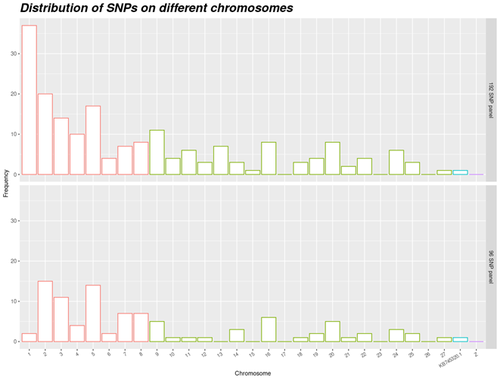
Cost-efficient assignment panel for ducks. Setup of a cost-efficient assignment panel for duck populations.Chapuis, Hervé, Brard-Fudulea, Sophie, Hazard, Azélie, Vignal, Alain, Demars, Julie, Rouger, Romuald, Teissier, Marc, Gilbert, Hélène https://hal.inrae.fr/hal-04542880Providing innovative genetic solutions to the future challenges of the poultry industry: extraction of a small-sized Single-nucleotide polymorphism (SNP) panel using factorial design for parentage assignment in a population consisting of pure and hybrid ducksRecommended by Seyed Abbas Rafat based on reviews by Arash Javanmard and 2 anonymous reviewers based on reviews by Arash Javanmard and 2 anonymous reviewers
One of the achievements of animal genetics is that it finds solutions along with the emergence of new needs of the animal husbandry community or the adoption of new laws. Muir and Cheng (2013) research serves as a classic example of using the innovations of animal genetics to meet new legal challenges, such as the restriction of beak cutting in laying hens. Muir and Cheng (2013) investigated the genetic diversity to deal with the cannibalism of intact chickens. In 2021, the European Citizens' Initiative urged the European Commission to legislate against the use of cages for farm animals in the livestock industry. Chapuis et al., (2024) presented a successful solution to the poultry industry about this (future) law by presenting a cost-efficient assignment SNP panel. In animal breeding, access to pedigree information is necessary for genetic progress. Since the 1970s, the development of genomic science and molecular techniques has shown their ability in this field. Despite the substantial reduction of genotyping costs in the last 20 years, the practical use of genome-wide genotyping for thousands of SNPs remains challenging. Therefore, the search for a small, cost-effective SNP panel is ongoing, with objectives including genetic diversity (Viale et al., 2017), product traceability (Dominik et al., 2021), species and hybrid identification (Harmoinen et al., 2021) and pedigree construction in wild populations (Ekblom et al., 2021). Furthermore, especially in recent decades, small panels of markers have been proposed for parentage assignment in different animals. For example, Domínguez-Viveros et al., (2020) developed panels with 42 to 63 markers for different sheep breeds in Mexico. Similar panels for parentage assignment have been proposed for salmon (May et al., 2020), rainbow trout (Liu et al., 2016), French sheep (Tortereau et al., 2017), Spanish sheep (Calvo et al., 2021), and European bison (Wehrenberg et al., 2024), with marker numbers of 142, 95, 180, 173, and 96, respectively. Massault et al., (2021) showed by simulation that a panel with at least 50 markers is sufficient for progeny assignment in pearl oysters. These examples highlight that extracting a small panel of markers (usually less than 200) from the total genotyping introduced in different species, can open new horizons for applying genomic information in animal breeding. Chapuis et al. (2024) addressed the challenge of finding an efficient set of markers that can be used in the hybridization of two species of the Pekin duck and the Muscovy duck. They used KASPar technology to setup a panel, with SNPs existing in both species and their hybrids. This panel has sufficient polymorphism to use in practice. Thus, it can be considered as a step forward compared to previous work done on microsatellites. A final list of SNPs was constructed from a reference set comprising 600 K genotyping of Anas platyrhynchos, Cairina moschata and mule duck. In addition to developing of a cost-efficient assignment panel, the work of Chapuis et al. (2024) presented a factorial design to maintain genetic diversity while considering specificities of duck production. The use of factorial design in avian pedigreed populations is relatively novel, making this research particularly innovative. The study's approach to factorial design in populations with limited size may be generalized to similar poultry species. Furthermore, sufficient effective size of population is selected. So, the panel can be used in other populations outside the tested populations. A notable feature of this panel is the use of neutral SNPs, which ensures that markers will not be lost due to future selection pressures over time. The paper of Chapuis et al. (2024) exemplifies the application of molecular genetics to address challenges in the poultry industry. The use of kinship matrix instead of relationship matrix, taking into account the unique characteristics of duck production, could be another novelty of the paper. According to the reviewers' comments, the results can be beneficial in the future, particularly with the introduction of the specific factorial design. References Calvo JH, Serrano M, Tortereau F, Sarto P, Iguacel LP, Jiménez MA, Folch J, Alabart JL, Fabre S and Lahoz B (2021). Development of a SNP parentage assignment panel in some North-Eastern Spanish meat sheep breeds. Spanish Journal of Agricultural Research 18, e0406. https://doi.org/10.5424/sjar/2020184-16805 Chapuis H, Brard-Fudulea S, Hazard A, Vignal A, Demars J, Rouger R, Teissier M, Gilbert H (2024). Cost-efficient assignment panel for ducks. Setup of a cost-efficient assignment panel for duck populations.: An illustration with experimental data. HAL, hal-04542880, ver. 2 peer-reviewed and recommended by Peer Community in Animal Science. https://hal.inrae.fr/hal-04542880 Domínguez-Viveros J, Rodríguez-Almeida FA, Jahuey-Martínez FJ, Martínez-Quintana JA, Aguilar-Palma GN, Ordoñez-Baquera P (2020). Definition of a SNP panel for paternity testing in ten sheep populations in Mexico, Small Ruminant Research ,193,106262. https://doi.org/10.1016/j.smallrumres.2020.106262 Dominik S, Duff CJ, Byrne AI, Daetwyler H, Reverter A (2021). Ultra-small SNP panels to uniquely identify individuals in thousands of samples. Animal Production Science 61, 1796–1800. https://doi.org/10.1071/AN21123 Ekblom R, Aronsson M, Elsner-Gearing F, Johansson M, Fountain T, Persson J (2021). Sample identification and pedigree reconstruction in Wolverine (Gulo gulo) using SNP genotyping of non-invasive samples. Conservation Genetics Resources 13, 261–274. https://doi.org/10.1007/s12686-021-01208-5 Harmoinen J, von Thaden A, Aspi J, Kvist L, Cocchiararo B, Jarausch A, Gazzola A, Sin T, Lohi H, Hytönen MK, Kojola I, Stronen AV, Caniglia R, Mattucci F, Galaverni M, Godinho R, Ruiz-González A, Randi E, Muñoz-Fuentes V, Nowak C (2021). Reliable wolf-dog hybrid detection in Europe using a reduced SNP panel developed for non-invasively collected samples. BMC Genomics 22, 473. https://doi.org/10.1186/s12864-021-07761-5 Liu S, Palti Y, Gao G, Rexroad CE (2016). Development and validation of a SNP panel for parentage assignment in rainbow trout. Aquaculture 452, 178–182. https://doi.org/10.1016/j.aquaculture.2015.11.001 Massault C, Jones DB, Zenger KR, Strugnell JM, Barnard R, Jerry DR (2021). A SNP parentage assignment panel for the silver lipped pearl oyster (Pinctada maxima). Aquaculture Reports 20, 100687. https://doi.org/10.1016/j.aqrep.2021.100687 May SA, McKinney GJ, Hilborn R, Hauser L, Naish KA (2020). Power of a dual-use SNP panel for pedigree reconstruction and population assignment. Ecology and Evolution 10, 9522–9531. https://doi.org/10.1002/ece3.6645 Muir WM, Cheng HW(2013). Genetics and the Behaviour of Chickens: Welfare and Productivity. In Genetics and the Behaviour of Domestic Animals. Vol. 2 (2nd ed.). pp. 1–30.ISBN: 9780128100165 Tortereau F, Moreno CR, Tosser-Klopp G, Servin B, Raoul J (2017). Development of a SNP panel dedicated to parentage assignment in French sheep populations. BMC Genetics 18, 50. https://doi.org/10.1186/s12863-017-0518-2 Viale E, Zanetti E, Özdemir D, Broccanello C, Dalmasso A, De Marchi M, Cassandro M (2017). Development and validation of a novel SNP panel for the genetic characterization of Italian chicken breeds by next-generation sequencing discovery and array genotyping. Poultry Science 96, 3858–3866. https://doi.org/10.3382/ps/pex238 Wehrenberg G, Tokarska M, Cocchiararo B, Nowak C (2024). A reduced SNP panel optimised for non-invasive genetic assessment of a genetically impoverished conservation icon, the European bison. Scientific Reports 14, 1875. https://doi.org/10.1038/s41598-024-51495-9
| Cost-efficient assignment panel for ducks. Setup of a cost-efficient assignment panel for duck populations. | Chapuis, Hervé, Brard-Fudulea, Sophie, Hazard, Azélie, Vignal, Alain, Demars, Julie, Rouger, Romuald, Teissier, Marc, Gilbert, Hélène | <p>The setup of a flexible and cost-effective 96-SNP assignment panel to be used in Pekin duck (<em>Anas platyrhynchos</em>), Muscovy duck (<em>Cairina moschata</em>) and their mule duck hybrid, is presented. SNP were selected on the available 600... |  | Animal genetics, Genomics | Seyed Abbas Rafat | 2024-04-12 09:45:59 | View | |
20 Aug 2024
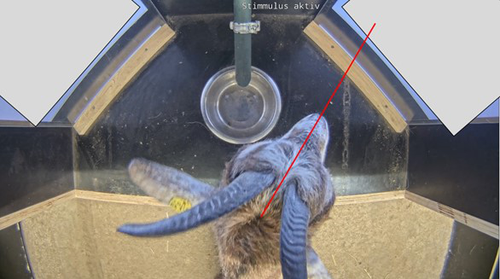
Goats who stare at video screens – assessing behavioural responses of goats towards images of familiar and unfamiliar con- and heterospecificsJana Deutsch, Steve Lebing, Anja Eggert, Christian Nawroth https://doi.org/10.31219/osf.io/d4nzkGazing behaviour as a tool to study goat cognitionRecommended by Isabelle Veissier based on reviews by Richard Bon and 1 anonymous reviewerMany cognitive studies use paradigms based on active decision-making, that require that animals are motivated to participate and interested in the reward (e.g. Rivas-Blanco et al., 2023). By contrast, looking time paradigms, in which the visual attention of an animal to a stimulus is measured, requires little training and little action from the subject, and can be used without reinforcement (e.g. Wilson et al., 2023). In this methodological paper, Jana Deutsch and her collaborators investigated the possibility of using a looking time paradigm to study perception and cognition in goats. The advantage of such a paradigm would be that it requires little training and can be used with no reinforcement. Goats were observed in front of two video screens presenting pictures of goats (familiar or not), of humans (familiar or not), or remaining white. The authors hypothesised that goats would pay more attention to pictures than to a white screen, would pay more attention to goats than to humans, and would discriminate familiar vs. unfamiliar beings. The goats had received previous positive contacts with the familiar humans. The goats were extensively habituated to the experimental set-up so that stress did not interfere in responses to testing. The stimuli were presented on the screens in a pseudorandomized and counterbalanced order. As hypothesised, goats looked longer at screen with pictures, and longer when the picture was that of another goat (familiar or not) than of a human being. Goats however did not seem to discriminate between familiar and unfamiliar being, or were equally motivated by the two types of beings. Ear postures were also recorded but did not show a relation with looking time and were not related to the type of picture shown on screens. Therefore, the authors argue that looking time but not ear posture is considered appropriate to test discrimination abilities or preferences in goats. More studies are needed to check if goats can differentiate familiar vs. unfamiliar beings. The experimental design is sound. The statistical analyses are rigorous and very relevant. The paper is clearly written. I recommend the manuscript for publication for its originality and its quality; In addition, the paper bring findings – that looking time is an adequate paradigm in goats to analyse how they pay attention to stimuli – that have potential impacts on further studies in animal cognition. References Deutsch, J., Lebing, S., Eggert, A., Nawroth, C. (2024). Goats who stare at video screens – assessing behavioural responses of goats towards images of familiar and unfamiliar con- and heterospecifics. OSF, ver.4 peer-reviewed and recommended by Peer Community In Animal Science. https://doi.org/10.31219/osf.io/d4nzk Rivas-Blanco, D., Monteiro, T., Virányi, Z., Range, F. (2024). Going back to “basics”: Harlow’s learning set task with wolves and dogs. Learning & Behavior. https://doi.org/10.3758/s13420-024-00631-6 Wilson, V. A. D., Bethell, E. J., Nawroth, C. (2023). The use of gaze to study cognition: limitations, solutions, and applications to animal welfare. Frontiers in Psychology, 14:1147278. https://doi.org/10.3389/fpsyg.2023.1147278
| Goats who stare at video screens – assessing behavioural responses of goats towards images of familiar and unfamiliar con- and heterospecifics | Jana Deutsch, Steve Lebing, Anja Eggert, Christian Nawroth | <p>Many cognitive paradigms rely on active decision-making, creating participation biases (e.g. subjects may lack motivation to participate in the training) and once-learned contingencies may bias the outcomes of subsequent similar tests. We here ... |  | Animal behaviour , Animal cognition, Animal welfare, Small ruminants | Isabelle Veissier | 2023-12-05 13:07:18 | View | |
24 May 2024
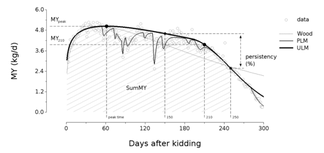
Diversity of performance patterns in dairy goats: multi-scale analysis of the lactation curves of milk yield, body condition score and body weightNicolas Gafsi, Olivier Martin, Fabrice Bidan, Bénédicte Grimard, Laurence Puillet https://doi.org/10.5281/zenodo.10101318Understanding milk and body reserves trajectories and nutrient partitioning in dairy goats through a modelling approachRecommended by Alberto Atzori based on reviews by Kristan Reed and 2 anonymous reviewersThe dairy sector is facing an historical period of high milk demand. However, increasing feed prices continually reduces the economic margins for farms. Managerial strategies to increase economical and technical awareness of animal performance, support the decision chain and optimize the use of production inputs are increasingly necessary, especially in goat farms with intensive production systems. Among the scientific goals, there is a particular emphasis on increasing knowledge about nutrition partitioning between milk production and body reserves — a topic that not easily addressed by nutritional models, limiting the attempts at production forecasting. The paper by Gafsi et al (2024) presents an interesting approach to studying phenotypic traits and trajectories of goat performance. It assesses the diversity of phenotypic trajectories reflecting functions such as milk production, body weight and condition score. This approaches aims to describe, understand and explore the interactions among biological functions and potential trade-offs of phenotypic trajectories across current and successive lactations. The work significantly contributes to the literature, particularly because previous descriptions of lactation curves relied primarily on mathematical outputs lacking information about the relationship among physiologically related variables. The analysis retrieved data from about 1500 goats over more than 20 years and was conducted with a multiscale approach. Data were fitted considering different types of models, including description of perturbations for lactation curves and with multiphasic models for the body weight and body condition score. Synthetic indicators were then estimated with a multivariate approach to define fitted trajectories and changes in performance.
Reference Gafsi N, Martin O, Bidan F, Grimard B, Puillet L (2024) Diversity of performance patterns in dairy goats: multi-scale analysis of the lactation curves of milk yield, body condition score and body weight. Zenodo. 10101318. ver.3 peer-reviewed and recommended by Peer Community In Animal Science. https://doi.org/10.5281/zenodo.10101318
| Diversity of performance patterns in dairy goats: multi-scale analysis of the lactation curves of milk yield, body condition score and body weight | Nicolas Gafsi, Olivier Martin, Fabrice Bidan, Bénédicte Grimard, Laurence Puillet | <p style="text-align: justify;">In the dairy goat sector, reduced longevity is a key issue leading to higher replacement rates in the herd and a poor dilution of doe rearing costs. There is a need to better understand the determinants of lifetime ... |  | Animal nutrition modelling, Lactation biology , Mathematical modelling, Physiology, Precision livestock farming, Small ruminants | Alberto Atzori | 2023-11-10 12:20:20 | View | |
15 Feb 2024
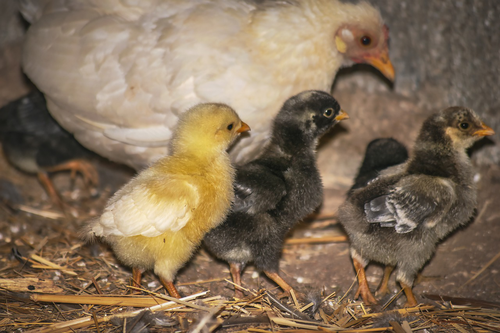
On-farm hatching and contact with adult hen post hatch induce sex-dependent effects on performance, health and robustness in broiler chickensL. A. Guilloteau, A. Bertin, S. Crochet, C. Bagnard, A. Hondelatte, L. Ravon, C. Schouler, K. Germain, A. Collin https://doi.org/10.1101/2023.05.17.541117The hen, the egg and the chick in conventional and on-farm hatching systemsRecommended by Florence Gondret based on reviews by Nicolas Bedere and Anna OlssonTo limit the use of antibiotics in the few days after hatching, it is necessary to improve the robustness of chicks during the early post-hatch period. This can be achieved by ensuring immediate access to feeds, optimizing the implantation and maturation of the microbiota and immune system of each chick, and minimizing exposure of stressors such as transportation. The study conducted by Guilloteau and colleagues (2024) compared the performance and health of chicks raised in conventional hatching systems with those raised in on-farm hatching systems. The authors showed that both systems yielded similar hatching percentage of eggs. Chicks from on-farm hatching systems exhibited higher body weights during the post-hatch period compared to those from conventional hatching, whereas health parameters were not affected by the system. An originality of the study was the examination of the benefits of the presence of an adult hen in hatching systems. The effects on chick traits were interpreted in relation to the hen behavior at hatching and a classification according to maternal or agonistic activities towards the chicks. However, the experimental design did not allow to make statistical correlations between hen behavior pattern and chick traits. Importantly, the presence of a hen decreased the hatching percentage, and this was likely associated with hen aggressiveness in the pen. The presence of the hen deteriorated the quality scores of the chicks in the on-farm hatching system, and increased mortality of chicks at hatching, negatively impacting chick weight gain and feed efficiency during the few days after hatching in both conventional and on-farm hatching systems. Thereafter, the effect of the presence of a hen on chick body weight was different according to the sex of the chicks and the type of hatching system. The presence of a hen did not reduce the parasitic load of the chicks nor improved clinical signs. No specific characterization of the fecal microbiota of the chicks was conducted, preventing the testing whether or not the presence of the hen affected the early implantation and maturation of the chick microbiome. Altogether, the data indicate that on-farm hatching systems are at least equivalent (in terms of health traits, feed efficiency) or even favorable (for faster growth in the early period after hatching) for chicks. Training the hens (considered as foster adults) to the presence of eggs and chicks or selecting hens according to specific activity behavioral patterns could be ways to establish better interactions between hens and chicks. Although the number and type of environmental stressors tested in the experiment differ from those in commercial farms, the article opens new perspectives for alternative hatching and farming practices. Reference Guilloteau LA, Bertin A, Crochet S, Bagnard C, Hondelatte A, Ravon L, Schouler C, Germain K, Collin A (2024) On-farm hatching and contact with adult hen post hatch induce sex-dependent effects on performance, health and robustness in broiler chickens. bioRxiv, 2023.05.17.541117. ver. 3 peer-reviewed and recommended by Peer Community in Animal Science. https://doi.org/10.1101/2023.05.17.541117.
| On-farm hatching and contact with adult hen post hatch induce sex-dependent effects on performance, health and robustness in broiler chickens | L. A. Guilloteau, A. Bertin, S. Crochet, C. Bagnard, A. Hondelatte, L. Ravon, C. Schouler, K. Germain, A. Collin | <p>To improve the early perinatal conditions of broiler chicks, alternative hatching systems have been developed. On-farm hatching (OFH) with an enriched microbial and stimulating environment by the presence of an adult hen is a promising solution... |  | Animal welfare, Farming systems, Poultry, Veterinary science | Florence Gondret | 2023-05-31 12:56:47 | View | |
09 Feb 2024
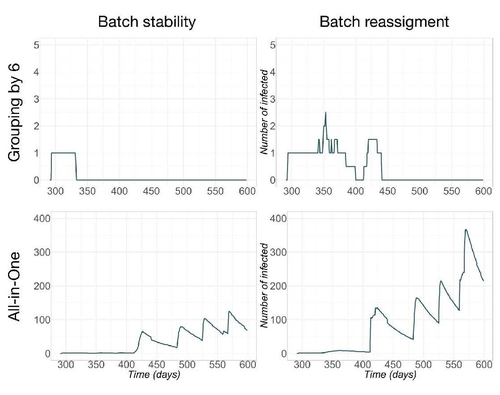
Pig herd management and infection transmission dynamics: a challenge for modellers.Vianney Sicard, Sébastien Picault, Mathieu Andraud https://doi.org/10.1101/2023.05.17.541128Towards models of infection transmission dynamicsRecommended by Marie-Pierre Letourneau Montminy based on reviews by Gustavo Machado and 1 anonymous reviewerEpidemics such as PRRSv-like virus in pig farms has tremendous impact on the competitiveness of swine production. However, its control requires an understanding of the complex interaction between pathogen transmission, disease impact, population dynamics and management. By using mechanistic epidemiological modelling, Sicard et al. (2023) open up a very interesting field of possibilities. This article describes work aimed at assessing the consequences of infections, taking into account the interaction between clinical outcomes and population dynamics. This study shows how this interaction can influence transmission dynamics at the herd level. It highlights the need to further explore this direction, integrating both disease impacts in breeding practices and structural changes in population dynamics, such as pig crossbreeding and grouping methodologies. Reference Sicard V, Picault S, Andraud M (2023) Pig herd management and infection transmission dynamics: a challenge for modellers. bioRxiv, 2023.05.17.541128. ver. 2 peer-reviewed and recommended by Peer Community in Animal Science. https://doi.org/10.1101/2023.05.17.541128
| Pig herd management and infection transmission dynamics: a challenge for modellers. | Vianney Sicard, Sébastien Picault, Mathieu Andraud | <p>The control of epidemics requires a thorough understanding of the complex interactions between pathogen transmission, disease impact, and population dynamics and management. Mechanistic epidemiological modelling is an effective way to address t... |  | Animal epidemiology modelling, Animal health, Bioinformatics, Farming systems, Infectious diseases, Mathematical modelling, Open science, Population dynamics, Veterinary epidemiology | Marie-Pierre Letourneau Montminy | 2023-05-22 15:07:37 | View | |
29 Jan 2024
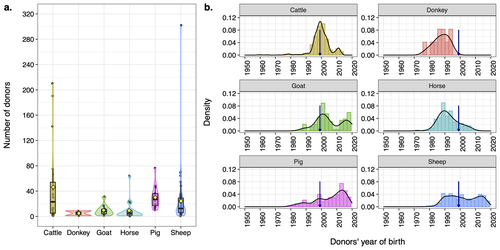
Assessing the potential of germplasm collections for the management of genetic diversity: the case of the French National CryobankAlicia Jacques, Delphine Duclos, Coralie Danchin-Burge, Marie-Jose Mercat, Michele Tixier-Boichard, Gwendal Restoux https://doi.org/10.1101/2023.07.19.549644Exploring Genetic Diversity Management: Unveiling the Potential of Germplasm Collections in the French National CryobankRecommended by Yuliaxis Ramayo-Caldas based on reviews by Roy Costilla and 1 anonymous reviewerThe study by Jacques et al. (2024) addresses a critical concern in the context of genetic diversity erosion in domesticated animal populations. The research uses data from the cryopreserved resources from the French National Cryobank to manage genetic diversity in livestock species. The authors employ a comprehensive methodology to propose novel biodiversity metrics to characterize the status of genetic diversity of cryopreserved collections including cattle, sheep, goat, horse, donkey, and pig livestock species. The findings reveal significant variations of genetic diversity at species and breed levels. Breeds with a large commercial distribution had more donors in the collection than local breeds. The authors propose a practical framework for assessing germplasm collections, providing a valuable tool for planning and managing collections at both national and international levels. The study also highlights the usefulness of the Gini-Simpson and effective donor numbers indices to plan a more efficient sampling, whereas the index of diversity impact can be employed in the selection of the most suitable donors for immediate use, based on pedigree but also using genetic markers. In resume, this study makes a significant contribution to the field by offering a framework for the assessment of germplasm collections. Its innovative metrics provide insights that could guide strategic decision-making in planning, managing, and utilizing cryopreserved resources. This research is relevant and can benefit conservationists, and population genetics working towards the preservation and sustainable use of genetic resources in livestock species. Reference Jacques, A., Duclos, D., Danchin-Burge, C., Mercat, M. J., Tixier-Boichard M., Restoux, G. (2024). Assessing the potential of germplasm collections for the management of genetic diversity: the case of the French National Cryobank. bioRxiv 2023.07.19.549644. ver. 3 peer-reviewed and recommended by Peer Community in Animal Science. https://doi.org/10.1101/2023.07.19.549644
| Assessing the potential of germplasm collections for the management of genetic diversity: the case of the French National Cryobank | Alicia Jacques, Delphine Duclos, Coralie Danchin-Burge, Marie-Jose Mercat, Michele Tixier-Boichard, Gwendal Restoux | <p>Through a combination of selective pressure and genetic drift, there has been a notable erosion of genetic diversity in domesticated animal populations. In response, many countries, including France, have developed gene banks in order to conser... |  | Animal genetics | Yuliaxis Ramayo-Caldas | 2023-07-20 19:08:40 | View | |
11 Dec 2023
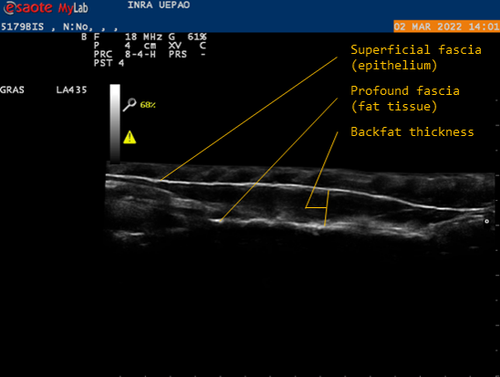
Genetic background of body reserves in laying hens through backfat thickness phenotypingNicolas Bédère, Joëlle Dupont, Yannick Baumard, Christophe Staub, David Gourichon, Frédéric Elleboudt, Pascale Le Roy, Tatiana Zerjal https://hal.inrae.fr/hal-04172576Towards a better optimization of the genetic improvement of chicken breeds: Introduction of simple phenotypic traits related to body composition for easy measurement in the selection programs of laying hens.Recommended by Seyed Abbas Rafat based on reviews by 2 anonymous reviewers based on reviews by 2 anonymous reviewers
In genetic selection, simplistic model of single-trait selection is usually considered, and the response to such approach is estimated using simple models. In practice, however, plant and animal breeders always deal with the selection of several traits, hence making the selection process very complex. Therefore, the simultaneous genetic improvement of several traits has always been one of the goals of livestock, including poultry breeding (Falconer, 1972). Studies that examine the indirect effects of selection on economic traits are eagerly awaited. In this context, the results of the study by Bédère et al., (2023) gives new insights about phenotypic and genotypic relationships between body reserves traits in laying hens. The authors aimed to propose novel data about the genetic architecture of traits related to body fat by measuring a series of phenotypic traits with relatively an easy approach. The authors further aimed to test and validate the phenotyping of backfat thickness as an indicator of the overall fatness of laying hens. Thus, the study allowed providing new evidence regarding the genetic determination of the backfat trait in chicken breeds. The authors first estimated the effect of selection on the residual feed intake (trait x) on the trait of body reserves (trait y). In fact, divergent selection experiments are a fundamental research tool that allow revealing significant amount of data related to the possible span of genetic improvement for traits of interest. Consequently, by analyzing data from a divergent selection experiment, associations have been estimated between a number of feed-dependent traits that have practical use for chicken breeders. Estimation of the correlations between traits is under question in terms of the theory of genetics and their application in multi-trait selection. As a major finding of the study, the observation of a bimodal distribution of backfat in both lines and the heterogeneity of the variances between families allowed suggesting a possible major gene, which could be investigated in future studies using for instance quantitative genetics. Body composition is continually studied in broilers chicken, but this aspect of chicken genetic is more detailed in laying hens. The current findings are worthy to validate using several approaches. In fact, one of the limitations of the study can be related to other statistical models that can be built. For example, the study revealed high correlations between egg production and body weight, thus body weight could be considered as a covariate in regression models. Moreover, the principal trait of selection (based on the residual feed intake) could be considered. References: Falconer, D. S. (1972). Introduction to Quantitative Genetics. Publisher: Ronald Press Company. pp 365. Bédère, N., Dupont, J., Baumard, Y., Staub, C., Gourichon, D., Elleboudt, F., Le Roy, P., Zerjal, T. (2023). Genetic background of body reserves in laying hens through backfat thickness phenotyping. HAL ver. 3 peer-reviewed and recommended by Peer Community in Animal Science. https://hal.inrae.fr/hal-04172576 | Genetic background of body reserves in laying hens through backfat thickness phenotyping | Nicolas Bédère, Joëlle Dupont, Yannick Baumard, Christophe Staub, David Gourichon, Frédéric Elleboudt, Pascale Le Roy, Tatiana Zerjal | <p>In this study, we pursued three primary objectives: firstly to test and validate the phenotyping of backfat thickness as an indicator of the overall fatness of laying hens; secondly, to estimate genetic parameters for this trait; thirdly, to st... |  | Animal genetics, Poultry, Statistical genetics | Seyed Abbas Rafat | 2023-07-27 17:09:10 | View | |
06 Sep 2023
Validation of a Radio frequency identification system for tracking location of laying hens in a quasi-commercial aviary systemSabine G. Gebhardt-Henrich, Alexander Kashev, Matthew B. Petelle, Michael J. Toscano https://doi.org/10.1101/2023.02.16.528820Tracking large numbers of hens in aviary housing: validation of a Radio Frequency Identification systemRecommended by Anna Olsson based on reviews by Arjen van Putten and Mona Giersberg based on reviews by Arjen van Putten and Mona Giersberg
With the increasing use of cage-free housing systems for laying hens comes the challenge of monitoring the behaviour of individual hens in large enclosures where they can be not only on the floors but on different levels. The aim of the present study by Gebhardt-Henrich et al., (2023) was to validate a Radio Frequency Identification (RFID) system with the capacity to track a large number of hens for different research and applied purposes where behaviour monitoring is relevant, such as heritability estimates for breeding programs. In a housing system with 225 birds per pens, 26 antennae were placed at different locations. All birds in 5 pens were equipped with a glass tag in a custom-developed leg band. For validation purposes, the behaviour of three hens who could move between two pens was also monitored on video. Equipping these hens with colour-coded backpacks made them identifiable on video. Matching the antennae detection of the focal birds with the behaviour observation showed that the antennae were able to detect a hen on the right tier in > 90% of cases, but that match on antenna level was lower. The limitations of the system are also discussed in this concise methods paper that will be helpful to many researchers interested in tracking laying hens in loose housing systems. Gebhardt-Henrich, S.G., Kashev, A., Petelle, M.B., Toscano, M.J., 2023. Validation of a Radio frequency identification system for tracking location of laying hens in a quasi-commercial aviary system. bioRxiv 2023.02.16.528820. ver. 3 peer-reviewed and recommended by Peer Community in Animal Science. https://doi.org/10.1101/2023.02.16.528820
| Validation of a Radio frequency identification system for tracking location of laying hens in a quasi-commercial aviary system | Sabine G. Gebhardt-Henrich, Alexander Kashev, Matthew B. Petelle, Michael J. Toscano | <p>Cage-free housing is increasingly chosen in Europe, North America, and Australia as an animal-welfare friendly farm system for laying hens. However, hens are kept in large numbers in those systems which makes checking for health and welfare dif... | Animal genetics, Animal welfare | Anna Olsson | 2023-02-17 08:54:51 | View | ||
23 Aug 2023
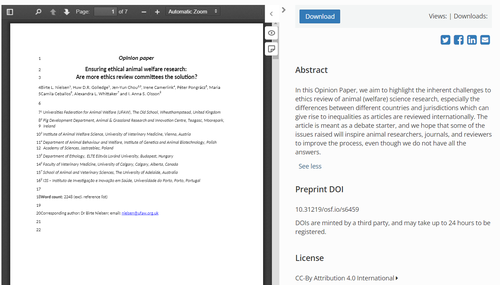
Ensuring ethical animal welfare research: Are more ethics review committees the solution?Birte L. Nielsen, Huw D.R. Golledge, Jen-Yun Chou, Irene Camerlink, Péter Pongrácz, Maria Camila Ceballos, Alexandra L. Whittaker and I. Anna S. Olsson https://www.doi.org/10.31219/osf.io/s6459Can a consensus be reached on the ethical review of animal experimentation for livestock species?Recommended by Hervé Acloque based on reviews by Christian Nawroth, Patrick Gonin and Leon borgdorf"Ensuring ethical animal welfare research: Are more ethics review committees the solution?" by Birte Nielsen and colleagues [1] provides food for thought on the ethical assessment of experiments involving farm animals. While regulations can provide a precise framework, they differ from country to country and do not consider several cases, mainly when the experimentation involves non- or minimally invasive manipulations. It is also the case when research projects use farmed animals that do not fall within the scope of the regulations on animal experimentation but have undergone practices that can be authorised on farms but may raise ethical questions (tail docking, live castration, tooth filing, beak trimming, dehorning). On the other hand, the heterogeneity of the criteria taken into account by the ethics committees, when they exist (and this can differ greatly from one country to another), do not necessarily correspond to the criteria of the journals, the reviewers and the bodies brought in to evaluate the research project, or to the regulations specific to each country. All these paradoxes lead the authors to propose solutions, the most straightforward and spontaneous of which is to ask ourselves questions about this issue upstream of the experimental design required to answer a given scientific question. While increasing the number of ethical review committees may be an insufficient option, the authors insist on the importance of improving committee members' training, taking into consideration jurisdictions' differences between countries and spending more time on ethics evaluation during manuscripts' reviewing. In addition, the upstream assessment of research projects by ethics committees, specific to an institution (research institute, universities, companies), a scientific publisher or even a dedicated international ethical review board may also be a good option. The ethical evaluation of research projects is a question at the heart of our research activities, for which we do not have all the answers. As with scientific reviewing, we must take on the role of evaluator or be evaluated ourselves, using criteria and feelings that are not always consensual. The heterogeneity of evaluation systems within the scientific community, the lack of training for scientists in the fundamentals of ethical evaluation, and the different perceptions of the animal condition between countries and cultures can lead to a reciprocal lack of understanding between evaluator and evaluated, and sometimes a feeling of injustice, as some research may be easy to conduct in one country but difficult in another. Indeed, it is exciting to read the exchanges between the authors and the three reviewers who assessed this opinion paper to appreciate the diversity of points of view and see specific points of divergence. In addition to animal experimentation, the judgment handed down on 30 June 2023 by the French court penalising a pig farmer for the abusive use of an authorised breeding practice (tail docking) is a perfect illustration of the fact that the ethical assessment of practices and handling of farm animals now extends far beyond the scientific world and is becoming an increasingly important factor in the relationship between society and animal breeding. Failure to consider this evolution, whether in experimentation or animal husbandry, may have legal consequences and increase the lack of understanding between our practices and how society perceives them. The questions raised and the solutions proposed in the article by Nielsen et al. are central to our concerns, not only for the scientific community but also to meet the expectations of all stakeholders. Finally, although the authors do not directly address the question of genome editing and research using edited farm animals, this is and will be at the heart of future issues concerning the ethical evaluation of research projects. As with practices and manipulations, the intentionality of the modifications induced leads us to question and evaluate, in farmed species, their consequences on animal welfare and their relevance to society and the development of more sustainable and socially accepted animal husbandry. Reference [1] Nielsen, B. L., Golledge, H. D. R., Chou, J., Camerlink, I., Pongrácz, P., Ceballos, M., Whittaker, A. L., Olsson, I. S. (2023) Ensuring ethical animal welfare research: Are more ethics review committees the solution? OSF Preprints. Ver. 3 peer-reviewed and recommended by Peer Community in Animal Science. https://doi.org/10.31219/osf.io/s6459 | Ensuring ethical animal welfare research: Are more ethics review committees the solution? | Birte L. Nielsen, Huw D.R. Golledge, Jen-Yun Chou, Irene Camerlink, Péter Pongrácz, Maria Camila Ceballos, Alexandra L. Whittaker and I. Anna S. Olsson | <p>As the article is a short Opinion Paper, it has no abstract, but it aims to highlight the inherent challenges to ethics review of animal (welfare) science research, especially the differences between different countries and jurisdictions which ... |  | Animal behaviour , Animal welfare, Open science, Veterinary science | Hervé Acloque | 2023-05-05 13:27:22 | View |
MANAGING BOARD
Karol B Barragán-Fonseca
Mohammed Gagaoua
Rachel Gervais
Florence Gondret
Francois Meurens
Rafael Muñoz-Tamayo
Anna Olsson
Seyed Abbas Rafat
Yuliaxis Ramayo-Caldas









